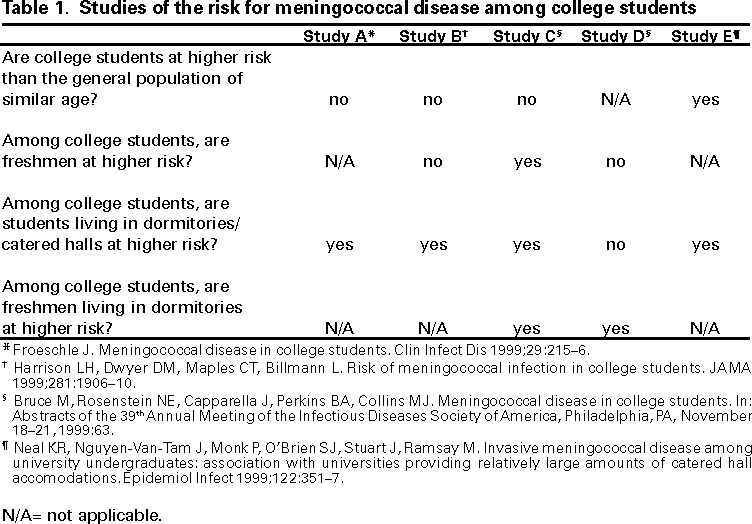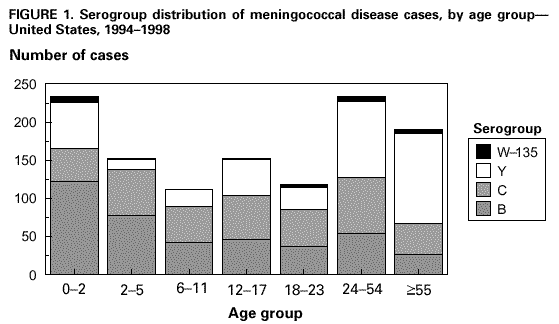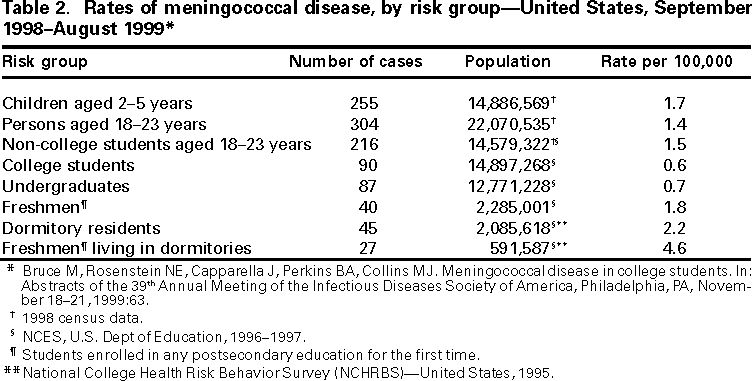 |
|
|
|
|
|
|
| ||||||||||
|
|
|
|
|
|
|
||||
| ||||||||||
|
|
|
|
|
Persons using assistive technology might not be able to fully access information in this file. For assistance, please send e-mail to: mmwrq@cdc.gov. Type 508 Accommodation and the title of the report in the subject line of e-mail. Meningococcal Disease and College StudentsRecommendations of the Advisory Committee on Immunization Practices (ACIP)SummaryThis report provides information regarding the modestly increased risk for meningococcal disease among college freshmen, particularly those who live in dormitories or residence halls. It presents recommendations developed by the Advisory Committee on Immunization Practices regarding the education of students and parents about meningococcal disease and the polysaccharide meningococcal vaccine so that they can make informed decisions regarding vaccination. INTRODUCTIONNeisseria meningitidis causes both sporadic disease and outbreaks. As a result of the control of Haemophilus influenzae type b infections, N. meningitidis has become the leading cause of bacterial meningitis in children and young adults in the United States (1). Outbreaks of meningococcal disease were rare in the United States in the 1980s; however, since 1991, the frequency of localized outbreaks has increased (2). From July 1994 through July 1997, 42 meningococcal outbreaks were reported, four of which occurred at colleges (3). However, outbreaks continue to represent <3% of total U.S. cases (3). Rates of meningococcal disease remain highest for infants, but in the past decade, rates have increased among adolescents and young adults (4). During 1994--1998, approximately two thirds of cases among persons aged 18--23 years were caused by serogroups C, Y, or W135 and therefore were potentially preventable with available vaccines (5) (CDC, unpublished data) (Figure 1). Although the quadrivalent meningococcal polysaccharide vaccine is safe and efficacious (5,6), decisions about who to target for vaccination require understanding of the groups at risk, the burden of disease, and the potential benefits of vaccination. New data are available regarding the risk for meningococcal disease in college students. This report reviews these data and provides medical professionals with guidelines concerning meningococcal disease and college students. BACKGROUNDMeningococcal Disease in the MilitaryMilitary recruits and college freshmen have several common characteristics (e.g., age, diverse geographic backgrounds, and crowded living conditions). Therefore, data obtained from recruits have been used to evaluate meningococcal disease and vaccine among college freshmen. Before 1971, rates of meningococcal disease were elevated among U.S. military recruits. Outbreaks frequently followed large-scale mobilizations, and recruits in their initial training camps were at substantially greater risk for disease than were regular troops (7). Military recruits enter military service for the first time at a few large U.S. military recruit training centers. After 8--12 weeks of initial training, they disperse to perform their military service at many different locations. During mobilization for the Vietnam conflict, outbreaks of meningococcal disease at training camps involving substantial numbers of recruits were caused by sulfadiazine-resistant strains of N. meningitidis. During 1964--1970, the rate of hospitalizations resulting from meningococcal disease among all active duty service members was 25.2 per 100,000 person- years (LTC Frederick Erdtmann, MD, MPH, Office of the Surgeon General, U.S. Army, briefing, 1981). These circumstances led to development of meningococcal polysaccharide vaccines (8). Field trials of group C polysaccharide vaccine among U.S. Army recruits demonstrated an 89.5% reduction in the rate of serogroup C meningococcal disease among vaccinated versus nonvaccinated recruits (9,10); thus, beginning in October 1971, all new recruits were vaccinated with the group C vaccine (11), and by Fall 1982, all recruits were receiving the quadrivalent polysaccharide vaccine (7). However, rates of meningococcal disease in U.S. Army personnel declined before the 1971 vaccination campaigns (7), suggesting that smaller recruit populations at training installations and the natural periodicity of outbreaks may have contributed to the decline in disease. Rates of meningococcal disease remain low in the military, and large outbreaks no longer occur. Since 1990, records of all hospitalizations of active duty service members in military hospitals worldwide have been integrated with military personnel records in the Defense Medical Surveillance System (DMSS). During 1990--1998, the overall rate of hospitalizations from meningococcal disease among enlisted, active-duty service members was 0.51 per 100,000 person-years (J. Brundage, DMSS Army Medical Surveillance Activity, personal communication). Approximately 180,000 military recruits receive a single dose of quadrivalent polysaccharide meningococcal vaccine annually. Revaccination is only indicated when military personnel are traveling to countries in which N. meningitidis is hyperendemic or epidemic (D. Trump, personal communication). Before 1999, students reporting to two of the U.S. military academies routinely received meningococcal vaccine. Last year, the other academies initiated meningococcal vaccine programs. MENINGOCOCCAL DISEASE AND COLLEGE STUDENTSFour recent studies provide data concerning the risk for sporadic meningococcal disease among college students (Table 1) (12--15). The earliest of these studies was conducted during the 1990--1991 and 1991--1992 school years. A questionnaire designed to evaluate risk factors for meningococcal disease among college students was sent to 1,900 universities, resulting in a 38% response rate (12). Forty-three cases of meningococcal disease were reported during the 2 years from colleges with a total enrollment of 4,393,744 students, for a low overall incidence of 1.0 per 100,000 population per year. However, cases of meningococcal disease occurred 9--23 times more frequently in students residing in dormitories than in those residing in other types of accommodations. The low response rate and the inability of the study to control for other risk factors (e.g., freshman status) make these results difficult to interpret. In a retrospective, cohort study conducted in Maryland for the period 1992--1997, 67 cases of meningococcal disease among persons aged 1630 years were identified by active, laboratory-based surveillance (13). Of those cases, 14 were among students attending Maryland colleges, and 11 were among those in 4-year colleges. The overall incidence of meningococcal disease in Maryland college students was similar to the incidence in the U.S. population of persons the same age (1.74/100,000 vs. 1.44/100,000, respectively); however, rates of disease were elevated among students living in dormitories compared with students living off-campus (3.2/100,000 vs. 0.96/100,000, p=0.05). U.S. surveillance for meningococcal disease in college students was initiated in 1998; from September 1998 through August 1999, 90 cases of meningococcal disease were reported to CDC (14). These cases represent approximately 3% of the total cases of meningococcal disease that occur each year in the United States. Eighty-seven (97%) cases occurred in undergraduate students, and 40 (44%) occurred among the 2.27 million freshman students entering college each year (16). Among undergraduates, of the 71 (82%) isolates for which serogroup information was available, 35 (49%) were serogroup C, 17 (24%) were serogroup B, 15 (21%) were serogroup Y, and one (1%) was serogroup W-135. Eight (9%) students died. Of the five students who died for whom serogroup information was available, four had serogroup C isolates and one had serogroup Y. U.S. surveillance data from the 1998--1999 school year suggest that the overall rate of meningococcal disease among undergraduate college students is lower than the rate among persons aged 18--23 years who are not enrolled in college (Table 2) (0.7 vs. 1.5/100,000, respectively) (14,16). However, rates were higher among specific subgroups of college students. Among the approximately 590,000 freshmen who live in dormitories (17), the rate of meningococcal disease was 4.6/100,000, higher than any age group in the population other than children aged <2 years, but lower than the threshold of 10/100,000 recommended for initiating meningococcal vaccination cam paigns (6). Of 90 students who had meningococcal disease attending college during the 1998-1999 school year, 50 were enrolled in a case-control study and matched to 148 controls by school, sex, and undergraduate vs. graduate status (14). In a multivariable analysis, freshmen living in dormitories were at higher risk for meningococcal disease. In addition, white race, radiator heat, and recent upper respiratory infection were associated with disease. In contrast to the United States, overall rates of meningococcal disease in the United Kingdom are higher among university students compared with non-students of similar age (15). From September 1994 through March 1997, university students had an increased annual rate of meningococcal disease (13.2/100,000) compared with non-students of similar age in the same health districts (5.5/100,000) and in those health districts without universities (3.7/100,000). As in the United States, regression analysis revealed that "catered hall accommodations," the U.K. equivalent of dormitories, were the main risk factor. Higher rates of disease were observed at universities providing catered hall accommodations for >10% of their student population compared with those providing such housing for <10% of students (15.3/100,000 vs. 5.9/100,000). The increased rate of disease among university students has prompted the United Kingdom to initiate routine vaccination of incoming university students with a bivalent A/C polysaccharide vaccine as part of a new vaccination program (see MMWR 2000; Vol.49, No. RR-6 which can be referenced in the pages preceding this report) (18). MENINGOCOCCAL VACCINE AND COLLEGE STUDENTSOn September 30, 1997, the American College Health Association (ACHA), which represents about half of colleges that have student health services, released a statement recommending that "college health services [take] a more proactive role in alerting students and their parents about the dangers of meningococcal disease," that "college students consider vaccination against potentially fatal meningococcal disease," and that "colleges and universities ensure all students have access to a vaccination program for those who want to be vaccinated" (Dr. MarJeanne Collins, Chairman, ACHA Vaccine Preventable Diseases Task Force, personal communication). Parent and college student advocates have also encouraged more widespread use of meningococcal vaccine in college students. In a joint study by ACHA and CDC, surveys were sent to 1,200 ACHA-member schools; of 691 responding schools, 57 (8%) reported that pre-exposure meningococcal vaccination campaigns had been conducted on their campus since September 1997. A median of 32 students were vaccinated at each school (range: 1--2,300) (J. Capparella, unpublished data). During the 1998--1999 school year, 3%--5% of 148 students enrolled in a case-control study reported receiving prophylactic meningococcal vaccination (14). Before the 1999 fall semester, many schools mailed information packets to incoming freshmen; data are not yet available regarding the proportion of students who have been vaccinated. Cost-effectiveness of meningococcal vaccine in college studentsFrom a societal perspective, the economic costs and benefits of vaccinating a) a cohort of 591,587 freshmen who live in dormitories and b) all freshman enrolled in U.S. colleges, regardless of housing status (n=2.4 million) were evaluated, assuming the benefits of vaccination would last 4 years (Scott et al, unpublished data). Best and worst case scenarios were evaluated by varying cost of vaccine and administration (range: $54--$88), costs per hospitalization ($10,924--$24,030), value of premature death based on lifetime productivity ($1.3--$4.8 million), cost of side effects of vaccine per case ($3,500--$12,270 per one million doses), and average cost of treating a case of sequelae ($0--$1,476). Vaccination coverage (60% and 100%) and vaccine efficacy (80% and 90%) were also varied for evaluation purposes. Vaccination of freshmen who live in dormitories would result in the administration of approximately 300,00--500,000 doses of vaccine each year, preventing 15--30 cases of meningococcal disease and one to three deaths each year. The cost per case prevented would be $600,000--$1.8 million, at a cost per death prevented of $7 million to $20 million. Vaccination of all freshman would result in the administration of approximately 1.4--2.3 million doses of vaccine each year, preventing 37--69 cases of meningococcal disease and two to four deaths caused by meningococcal disease each year. The cost per case prevented would be $1.4--2.9 million, at a cost per death prevented of $22 million to $48 million. These data are similar to data derived from previous studies (19). They suggest that for society as a whole, vaccination of college students is unlikely to be cost-effective (Scott et al, unpublished data). RECOMMENDATIONS FOR USE OF MENINGOCOCCAL POLYSACCHARIDE VACCINE IN COLLEGE STUDENTSCollege freshmen, particularly those who live in dormitories, are at modestly increased risk for meningococcal disease relative to other persons their age. Vaccination with the currently available quadrivalent meningococcal polysaccharide vaccine will decrease the risk for meningococcal disease among such persons. Vaccination does not eliminate risk because a) the vaccine confers no protection against serogroup B disease and b) although the vaccine is highly effective against serogroups C, Y, W-135, and A, efficacy is <100%. The risk for meningococcal disease among college students is low; therefore, vaccination of all college students, all freshmen, or only freshmen who live in dormitories or residence halls is not likely to be cost-effective for society as a whole. Thus, ACIP is issuing the following recommendations regarding the use of meningococcal polysaccharide vaccines for college students.
Additional Considerations about Vaccination of College StudentsAlthough the need for revaccination of older children has not been determined, antibody levels decline rapidly over 2--3 years (6). Revaccination may be considered for freshmen who were vaccinated more than 3--5 years earlier (5). Routine revaccination of college students who were vaccinated as freshmen is not indicated. College students who are at higher risk for meningococcal disease because of a) underlying immune deficiencies or b) travel to countries in which N. meningitidis is hyperendemic or epidemic (i.e., the meningitis belt of sub-Saharan Africa) should be vaccinated (6). College students who are employed as research, industrial, and clinical laboratory personnel who are routinely exposed to N. meningitidis in solutions that may be aerosolized should be considered for vaccination (6). No data are available regarding whether other closed civilian populations with characteristics similar to college freshman living in dormitories (e.g., preparatory school students) are at the same increased risk for disease. Prevention efforts should focus on groups in whom higher risk has been documented. CONCLUSIONSCollege freshmen, especially those who live in dormitories, are at a modestly increased risk for meningococcal disease compared with other persons of the same age, and vaccination with the currently available quadrivalent meningococcal polysaccharide vaccine will decrease their risk for meningococcal disease. Continued surveillance is necessary to evaluate the impact of these recommendations, which have already prompted many universities and clinicians to offer vaccine to college freshmen. Consultation on the use of these recommendations or other issues regarding meningococcal disease is available from the Meningitis and Special Pathogens Branch, Division of Bacterial and Mycotic Diseases, National Center for Infectious Diseases, CDC (telephone: [404] 639-3158). AcknowledgementThe following persons are acknowledged for their contributions to the economics section of this report: Martin I. Meltzer, Ph.D. and R. Douglas Scott, II, Ph.D. References
Table 1  Return to top. Figure 1  Return to top. Table 2  Return to top. Disclaimer All MMWR HTML versions of articles are electronic conversions from ASCII text into HTML. This conversion may have resulted in character translation or format errors in the HTML version. Users should not rely on this HTML document, but are referred to the electronic PDF version and/or the original MMWR paper copy for the official text, figures, and tables. An original paper copy of this issue can be obtained from the Superintendent of Documents, U.S. Government Printing Office (GPO), Washington, DC 20402-9371; telephone: (202) 512-1800. Contact GPO for current prices. **Questions or messages regarding errors in formatting should be addressed to mmwrq@cdc.gov.Page converted: 6/27/2000 |
|||||||||
This page last reviewed 5/2/01
|